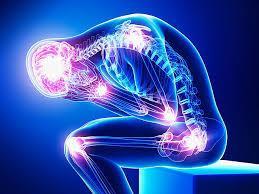Understanding Pain: A Comprehensive Analysis
Pain is a universal experience, a complex and multifaceted phenomenon that affects every individual at some point in their lives. Despite its common occurrence, pain remains a deeply personal and subjective experience, often challenging to define and quantify. In this article, we will delve into the definition of pain, explore its various types, mechanisms, and the profound impact it has on both the body and mind.
The Biological Basis of Pain
Pain is essentially a protective mechanism. It alerts us to potential or actual damage to our bodies, prompting actions to avoid harm and initiate healing processes.
Nociception refers to the process by which pain signals are transmitted from the site of injury or threat to the brain. This involves a complex network of neurons and biochemical processes. Here’s a brief overview of the pain pathway:
- Transduction: Nociceptors (pain receptors) detect harmful stimuli such as thermal, mechanical, or chemical changes. These stimuli are converted into electrical signals.
- Transmission: These electrical signals travel along peripheral nerves to the spinal cord and then to the brain.
- Perception: The brain processes these signals, and the individual becomes consciously aware of the pain.
- Modulation: The brain can also send signals back down the spinal cord to modulate pain intensity.
Types of Pain
Understanding the different types of pain is crucial for effective diagnosis and treatment. Pain is generally classified into several categories:
- Acute Pain: This type of pain is typically short-lived and directly related to tissue damage, such as a cut, burn, or surgical procedure.
- Chronic Pain: Chronic pain persists for longer periods, often beyond the expected period of healing. It can be associated with conditions like arthritis, fibromyalgia, or neuropathy.
- Neuropathic Pain: Caused by damage or dysfunction in the nervous system, neuropathic pain is often described as burning, tingling, or shooting pain. Conditions like diabetes or shingles can cause this type of pain.
- Nociceptive Pain: Resulting from actual tissue damage or inflammation, nociceptive pain is often classified into somatic (affecting bones, muscles, joints) and visceral (affecting internal organs) pain.
The Psychological Dimension of Pain
The perception of pain is influenced by various factors, including mood, attention, previous experiences, and cultural context. This multifaceted nature makes pain management a complex task, often requiring a multidisciplinary approach.
Psychosocial Factors Influencing Pain
Several psychosocial factors can influence the perception and experience of pain:
- Emotional State: Anxiety, depression, and stress can amplify the perception of pain, making it feel more intense.
- Cognitive Factors: How we think about pain can affect how we experience it. Catastrophizing, or expecting the worst, can increase pain severity.
- Social Support: A strong support system can provide emotional comfort and improve pain coping mechanisms.
- Cultural Beliefs: Cultural attitudes towards pain can shape how individuals express and manage their pain.
Pain and Quality of Life
Chronic pain can significantly impact an individual’s quality of life, affecting their ability to work, engage in social activities, and perform daily tasks. It can lead to emotional distress, sleep disturbances, and a decline in physical health. Effective pain management is crucial to improve the overall well-being of individuals suffering from chronic pain.
Modern Approaches to Pain Management
Pain management is a dynamic field that involves various strategies to alleviate pain and improve patients’ quality of life. These strategies can be broadly categorized into pharmacological and non-pharmacological treatments.
Pharmacological Treatments
- Analgesics: These are drugs specifically designed to relieve pain. They include over-the-counter options like acetaminophen and ibuprofen, as well as prescription medications such as opioids.
- Nonsteroidal Anti-Inflammatory Drugs (NSAIDs): These drugs reduce inflammation and alleviate pain. Common examples include aspirin and naproxen.
- Adjuvant Medications: These are drugs not primarily designed to treat pain but can be effective for certain types of pain. Examples include antidepressants and anticonvulsants.
- Muscle Relaxants: Medications such as Prosoma 500 can be prescribed to alleviate muscle pain and spasms, providing significant relief for certain types of pain.
Non-Pharmacological Treatments
- Physical Therapy: Exercises and physical activities designed to improve mobility and strengthen muscles, which can help manage pain.
- Cognitive Behavioral Therapy (CBT): A psychological approach that helps patients manage pain by changing negative thought patterns and behaviors.
- Acupuncture: An ancient Chinese practice that involves inserting thin needles into specific points on the body to relieve pain.
- Mind-Body Techniques: Methods such as meditation, yoga, and biofeedback that focus on the connection between the mind and body to reduce pain.
Emerging Trends in Pain Research
Advancements in science and technology are continually shaping the landscape of pain research and management. Some of the emerging trends include:
- Personalized Pain Management: Tailoring pain treatment plans based on genetic, environmental, and lifestyle factors of the individual.
- Neuromodulation: Techniques like spinal cord stimulation and transcutaneous electrical nerve stimulation (TENS) that alter nerve activity to reduce pain.
- Regenerative Medicine: Exploring the use of stem cells and other regenerative techniques to repair damaged tissues and alleviate pain.
Conclusion
Pain is a complex and multifaceted experience that encompasses physical, emotional, and psychological dimensions. Understanding its mechanisms and the various factors influencing its perception is crucial for effective management. Advances in pain research continue to offer new insights and innovative treatments, providing hope for better pain relief and improved quality of life for those affected.




